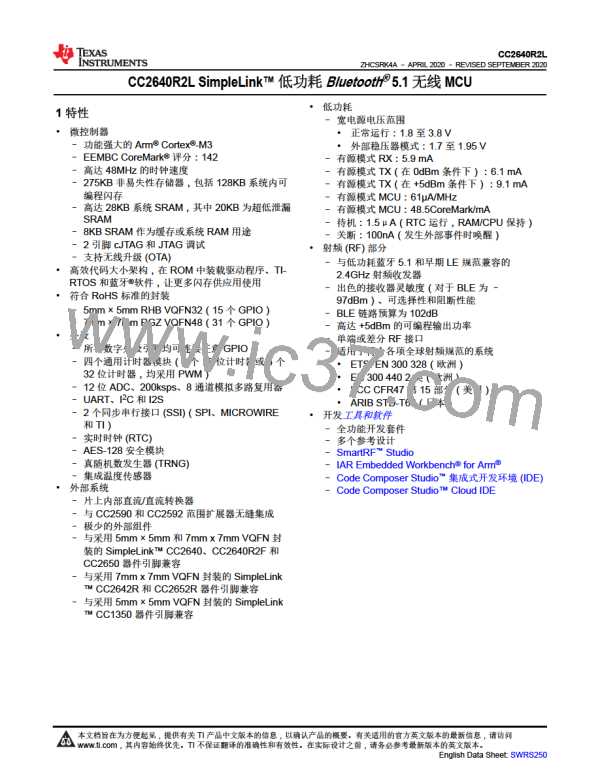CC2640R2L
ZHCSRK4A –APRIL 2020 –REVISED SEPTEMBER 2020
www.ti.com.cn
9.6 Debug
The on-chip debug support is done through a dedicated cJTAG (IEEE 1149.7) or JTAG (IEEE 1149.1) interface.
9.7 Power Management
To minimize power consumption, the CC2640R2L MCU supports a number of power modes and power
management features (see 表9-1).
表9-1. Power Modes
SOFTWARE CONFIGURABLE POWER MODES
RESET PIN
HELD
MODE
ACTIVE
IDLE
Off
STANDBY
Off
SHUTDOWN
CPU
Active
Off
Off
Off
Off
Flash
On
Available
On
Off
SRAM
On
Available
On
Off
Off
Radio
Available
On
Off
Off
Off
Supply System
Current
On
Duty Cycled
1.5 µA
151 µs
Partial
Full
Off
Off
1.45 mA + 31 µA/MHz
650 µA
14 µs
Full
0.15 µA
1015 µs
No
0.1 µA
1015 µs
No
Wake-up Time to CPU Active(1)
Register Retention
SRAM Retention
–
Full
Full
Full
No
No
XOSC_HF or
RCOSC_HF
XOSC_HF or
RCOSC_HF
High-Speed Clock
Low-Speed Clock
Off
Off
Off
Off
Off
XOSC_LF or
RCOSC_LF
XOSC_LF or
RCOSC_LF
XOSC_LF or
RCOSC_LF
Peripherals
Available
Available
Available
Available
Active
Available
Available
Available
Available
Active
Off
Off
Off
Off
Off
Wake up on RTC
Available
Available
Available
Duty Cycled
Active
Wake up on Pin Edge
Wake up on Reset Pin
Brown Out Detector (BOD)
Power On Reset (POR)
Available
Available
Off
Off
Available
N/A
Active
Active
Active
N/A
(1) Not including RTOS overhead
In active mode, the application CM3 CPU is actively executing code. Active mode provides normal operation of
the processor and all of the peripherals that are currently enabled. The system clock can be any available clock
source (see 表9-1).
In idle mode, all active peripherals can be clocked, but the Application CPU core and memory are not clocked
and no code is executed. Any interrupt event will bring the processor back into active mode.
In standby mode, only the always-on domain (AON) is active. An external wake-up event or RTC event is
required to bring the device back to active mode. MCU peripherals with retention do not need to be reconfigured
when waking up again, and the CPU continues execution from where it went into standby mode. All GPIOs are
latched in standby mode.
In shutdown mode, the device is turned off entirely, including the AON domain. The I/Os are latched with the
value they had before entering shutdown mode. A change of state on any I/O pin defined as a wake-up from
Shutdown pin wakes up the device and functions as a reset trigger. The CPU can differentiate between a reset in
this way, a reset-by-reset pin, or a power-on-reset by reading the reset status register. The only state retained in
this mode is the latched I/O state and the Flash memory contents.
Copyright © 2023 Texas Instruments Incorporated
Submit Document Feedback
31

 TI [ TEXAS INSTRUMENTS ]
TI [ TEXAS INSTRUMENTS ]